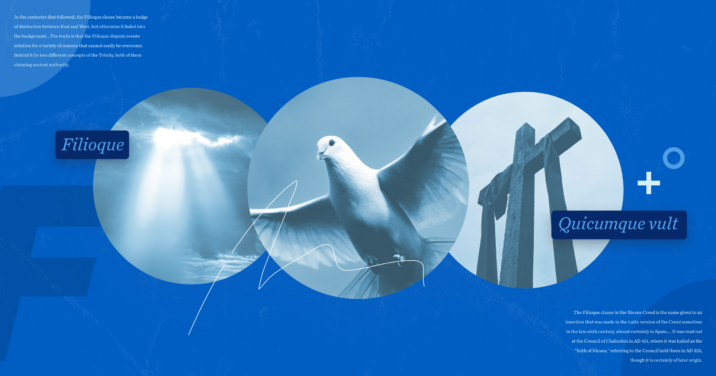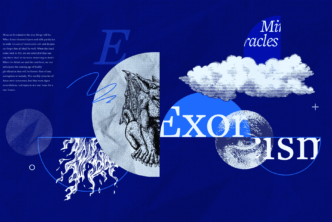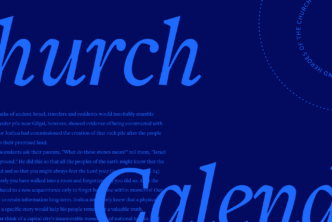The Filioque clause in the Nicene Creed is the name given to an insertion that was made in the Latin version of the creed sometime in the late-sixth century, almost certainly in Spain. The creed itself was originally composed in Greek, most probably at or shortly after the First Council of Constantinople AD 381. It was read out at the Council of Chalcedon in 451, where it was hailed as the “faith of Nicaea,” referring to the council held there in 325, though it is certainly of later origin. The original version read, “We believe in the Holy Spirit, who proceeds from the Father,” a statement taken directly from John 15:26, which is recorded there as coming from Jesus himself. In this article, we’ll guide you through the history and theology of the Filioque clause.
- How do the Spirit and Son differ?
- What did Augustine think?
- The Athanasian Creed
- What is Arianism?
- The role of the Bulgars
- The Crusades, Anslem, and the Filioque
- How far the East is from the West
- East-West reunion
- East and West divided again
- Modern interest in the Flioque
- Conclusion
How do the Spirit and Son differ?
The Holy Spirit is said to proceed from the Father, in distinction to the Son, who is eternally begotten from him. Nobody can define what the difference was between begetting (or “generation”) and procession, but it is generally agreed that different words were used to distinguish the relationship of the Son to the Father from that of the Holy Spirit. Some medieval theologians interpreted the generation of the Son as a kind of procession, but never the other way around. That would have made the Holy Spirit the Son’s twin brother, which would have gone against John 1:14, where the Son is described as the “only begotten.” What is left undetermined in the original Nicene Creed is the relationship between the Son and the Holy Spirit.
What did Augustine think?
Nobody in the Greek-speaking world seems to have been disturbed by this omission, but there are indications that the Latin-speaking church noticed it and wanted to address the question. The first person to do so in any depth was Augustine of Hippo (AD 354–430). Writing shortly after AD 400, and possibly in ignorance of the Nicene Creed (which he never mentioned), Augustine developed a doctrine of the Trinity based on the premise that “God is love” (1 John 4:15). Love is only meaningful in the context of relationship, and so Augustine concluded that in the Godhead, the Father is the One who loves, the Son is the One who is loved (“the Beloved”), and the Holy Spirit is the “bond of love” who unites them. According to this scheme, the Son’s love for the Father must equal and complement the Father’s love for the Son, since otherwise there would be an imbalance in their relationship. There was thus a double procession of the Holy Spirit—from the Father and from the Son.
The Athanasian Creed
Translated into Creedal terminology, this means that the Holy Spirit must proceed from the Son as well as from the Father, and to an equal degree. That doctrine made its first appearance in the so-called Athanasian Creed (also known as the Quicumque vult, from its opening words in Latin: “He who wishes to be saved … ”). Although later theologians attributed this Creed to Athanasius (286–373), bishop of Alexandria from AD 328 onwards, it is now known that it was composed sometime around AD 500, and most probably in southern Gaul (now France). It was also written in Latin, a language that Athanasius did not use, and it never circulated in the Greek-speaking world. In later controversies, the Western (Latin) church used this mistaken attribution as evidence that the leading Greek exponent of orthodoxy accepted the double procession, whereas their Greek opponents denounced it as a forgery and a fraud.
What is Arianism?
When the Nicene Creed was translated into Latin, the text followed the Greek original; but the church came up against the problem of Arianism, which was then the official belief of the Visigothic rulers of Spain. Arianism taught that the Son was inferior to the Father, and it used the procession of the Holy Spirit from the Father as an example of how he was “greater” than the Son, who was not mentioned in the Nicene Creed or in John 15:26. In order to counter this, proponents of the mainline (“catholic”) church relied on Augustine and the Quicumque vult to insist that the Holy Spirit proceeds from the Son also.
The Visigoths abandoned Arianism at the Third Council of Toledo in 589, and it is usually said that the Nicene Creed was altered at that time to include a reference to the double procession of the Holy Spirit—but there is no evidence for this assertion. Most probably the double procession was added to the creed either shortly before or (more probably) shortly after 589, as a safeguard against any possible relapse into Arianism. In its Latin form, the creed then ran:
|
Latin |
English translation |
|
[Credimus] et in Spiritum Sanctum, qui ex Patre Filioque procedit. | [We believe] also in the Holy Spirit, who proceeds from the Father and from the Son. |
Nobody knows who made this addition or on what authority, but it was accepted across Spain and slowly made its way into Gaul (France) as well. There the Emperor Charlemagne (778–814) commissioned his theologians to revise the liturgies of the church, and among other things, they included the Nicene Creed, in its Spanish form, in the rite of Holy Communion. Some of them even went so far as to claim that the absence of the Filioque clause from the Greek version of the creed came about because the Greeks had fallen into heresy and had erased it from the original text! At the time, Rome objected to the addition of the word Filioque to the creed and refused to include the word(s)1 in its version of the creed. Needless to say, the Greek-speaking churches of the East never added the word, either; and when they heard about it, they too objected. For a while it seemed as though the matter would be forgotten, especially after Charlemagne’s empire broke up and Rome continued to resist what it saw as an innovation.
The role of the Bulgars
Matters might have rested there, but conflict developed in Bulgaria, when Western (Latin) missionaries tried to convert the Bulgars to Christianity and unite them with the Roman church. Bulgaria was too close to Constantinople (formerly Byzantium and now Istanbul), the heart of the Greek-speaking world, for the Greek church to be able to accept that. One of the arguments they used to persuade the Bulgarians that the Western missionaries were wrong was the fact that they had added Filioque to the creed, where it did not belong. The patriarch (bishop) of Constantinople, a man called Photius (d. ca. 895), took up his pen in opposition to the Latin insertion. He argued that it was not just irregular (on the ground that it had been added to the creed without authorization by a church council) but also that it was wrong in itself.
Photius knew nothing of Augustine or of the Quicumque vult, nor did he appreciate the anti-Arian thrust of the addition. Instead, he argued that because God is One, there can be only one source of divinity, and that is the Father. The Son is begotten of the Father alone, which means that he is God because the Father is God. In the same way, said Photius, the Holy Spirit proceeds from the Father alone, which makes him God just as much as the Son is. According to him, if the Holy Spirit proceeded from the Son as well, there would be two sources of divinity, and monotheism would be destroyed. That was obviously impossible, and so the Filioque clause had to be rejected as heretical. The Bulgarians accepted that logic and became Eastern (Greek) Christians instead of Western (Latin) ones, a situation that continues to this day.
The Crusades, Anselm, and the Filioque
Photius’ writings were not translated into Latin, and the theological issues related to the Filioque were largely forgotten. Awareness of the problem resurfaced in the late-eleventh century, however, because in 1071 the remaining Greek-speaking areas of southern Italy fell into Western hands. A few years later, the Greeks (Byzantines) appealed to the West for help against the Muslim Turks, who were invading their empire and threatening Constantinople itself. This led to the Crusades, when Western armies marched to the East in order to liberate the Christians there from Muslim rule and reclaim the Holy Land.
Until that time, most ordinary Christians in both West and East had no idea that their churches were different; but direct contact made them realize that they were. Anselm (1033–1109), archbishop of Canterbury, had gone into exile to Bari, in southern Italy, where he met Greek Christians face to face and had to confront their doctrine of the Holy Spirit firsthand. He produced a treatise on the subject of the double procession, which relied extensively on the Fourth Gospel for its arguments. Anselm could not object to John 15:26, but he tried to read it in the wider context of the Farewell Discourses of Jesus (John 14–16) and the rest of the New Testament. By doing so, he was able to show that the Holy Spirit is the Spirit of the Son (see Gal 4:6, for example), and from that he concluded that the double procession was a logical necessity, implied by the biblical text though not explicitly stated in it.
How far the East is from the West
From then on, there was increasing debate about the question, which came to be seen as an impediment to the unity of the churches of East and West, which everyone desired. In the course of these debates, the arguments were more precisely defined. Both sides agreed that the Son sends the Holy Spirit, which is what Jesus himself taught; and in that sense the Spirit could be said to proceed from both the Father and the Son. The debate was not about the Spirit’s mission, as this sending was called, but about his eternal relationship to the other persons of the Godhead.
The Eastern churches were prepared to accept that the Holy Spirit proceeds from the Father through the Son, basing this on the baptism of Jesus, where the Spirit rested on him like a dove—and on the transfiguration, when Jesus was illuminated by the Holy Spirit and thereby was revealed to his disciples as God in human flesh. What they could not accept was that the Spirit derived his origin from the Son as well as from the Father, because (as Photius had argued) there can be only one source of divinity in God.
The Western counterargument to this was that the revelation of the Trinity on earth must reflect the being of the Trinity in heaven. Therefore, if the Son sends the Holy Spirit to us on earth, it must be because he proceeds from the Son in heaven as well. If that were not the case, there would be a discrepancy between the eternal Godhead and his manifestation in time, which would raise the question of whether the revelation we have of God is authentic or not. If our perception of God is not the same as God is in himself, can we say that we have any true knowledge of him?
East-West reunion
These debates were those of theologians and might have remained at that level had other factors not intervened. The Roman church, which had long resisted adding Filioque to its text of the Nicene Creed, finally did so about 1014. A generation later, the papacy underwent serious reform and soon became the most powerful force in Western Europe. The popes wanted to claim the allegiance of the entire church, including the Greek East, which had never recognized Roman rule. Submission to the papacy would have included acceptance of the Filioque clause, because it had been approved by Rome; and that the East refused to contemplate. Matters came to a head in 1204, when the Fourth Crusade conquered Constantinople and the church there was forcibly subordinated to the pope. The Greeks recovered the city in 1261, but the Byzantine Emperor Michael VIII (1258–1282) knew that he had to come to terms with the Western church if a similar disaster were to be averted in the future.
Meanwhile, the years of Western domination had witnessed a growing interest among the Greeks in Latin (Western) theology, and not a few of them were converted to the Western way of thinking. These so-called Latinophrones were a minority, but they were influential, and they helped to steer Michael VIII towards reunion with the West. This was achieved at the Second Council of Lyons in 1274, but at the price of submission to the pope, which meant acceptance of the Filioque. It was a deal that was eventually rejected in the East, but it ensured that the debate would now become political as much, if not more, than theological.
In the fourteenth century there was a revival of mystical theology in the East, associated with the name of Gregory Palamas (1296–1359). Palamas was not particularly anti-Western, but he was able to show that Eastern theology had resources that it could develop without surrendering to the West. The political situation of the Byzantine Greek world continued to deteriorate, until by the early fifteenth century there was little more than Constantinople left to the empire. The Muslim Turks were encroaching on it, and it was only a matter of time before they would conquer it, as they did in 1453.
Facing a desperate situation, Emperor John VIII (1425–1448) made another bid for Western help by entering into union with the papacy. This was achieved—on paper at least—at the Council of Florence in 1439, when it was agreed that the Western doctrine of the double procession of the Holy Spirit from the Father and the Son was equivalent to the Eastern understanding that the Holy Spirit proceeds from the Father through the Son, whether that was really true or not. The Western church accepted this formula, which it has maintained to the present day, but the East felt pressured and its theologians doubted whether the proposed solution would really solve the problem. After the fall of Constantinople the Eastern churches repudiated the union with Rome and went their own way, as they continue to do today.
East and West divided again
In the centuries that followed, the Filioque clause became a badge of distinction between East and West, but otherwise it faded into the background. When the Western church split into Protestant and Roman Catholic parts in the sixteenth century, the Filioque scarcely figured in the conflict. Protestants and Catholics both vied for support from the Eastern churches, but with little success. Rome continued to court the East with reunion proposals formed on the basis of the Council of Florence, with the result that Uniate, or so-called “Greek Catholic” churches were formed in Poland, Ukraine, and elsewhere. Those churches were permitted to recite the Nicene Creed without the Filioque, but they had to accept the theology behind it as part of the union with Rome. Protestant missions to the East were less successful, but to the extent that they were able to establish churches there, the Filioque was regarded as optional and largely ignored in practice.
Modern interest in the Filioque
It was only in the twentieth century that interest in the doctrine reappeared, largely in the context of the ecumenical movement. Growing historical awareness in the West made many theologians more sympathetic to the Eastern position, because it was obvious that the West had accepted the Filioque without bothering to consult with the East and had often behaved badly towards the Easterners in the centuries since. Eastern theologians, by contrast, often became more conscious of their own heritage, and some, like Vladimir Lossky (1903–1958), went so far as to blame the Russian revolution on alien Western influences, including the Filioque clause, which he tended to see as an instrument of papal domination.
Western liberalism and Eastern intransigence led to a tendency to downplay the Filioque, and even to expunge it from Western versions of the Nicene Creed, though this seldom affected the use of the creed in particular congregations. But serious interest in the doctrine revived in many quarters, and not least among Protestants, where it had usually been neglected. Jurgen Moltmann (1926–) in particular took on the challenge of reconceiving it, and came up with the formula that the Holy Spirit proceeds from the Father of the Son. The logic behind this is that although we can say that the Holy Spirit proceeds from the Father, the Father is already the Father of the Son, who therefore must also be involved in the procession. It is an ingenious attempt to resolve an intractable problem, but it has to be said that, so far at least, it has not proved to be very persuasive.
Conclusion
The truth is that the Filioque dispute resists solution for a variety of reasons that cannot easily be overcome. Behind it lie two different concepts of the Trinity, both of them claiming ancient authority. For the West to renounce the doctrine would undermine its belief that the Holy Spirit does the work of the Son in the world, as Galatians 4:6 makes clear. For the East, to accept it appears as surrender to an alien way of thinking that has done so much damage to it in the past and seems to offer nothing but absorption into a Western mindset and a loss of its own heritage. It would be wrong to say that no solution is possible, but if one is to be found, it will have to transcend the limitations of our present theological models, put aside the hurts and failings of the past, and settle on a new understanding that does justice to the biblical evidence without relapsing into traditional ways of thinking. For that, we must pray for the grace of God and a renewal that only the Holy Spirit, who is himself the object of our inquiry, can bring to our finite intelligence of the divine.







